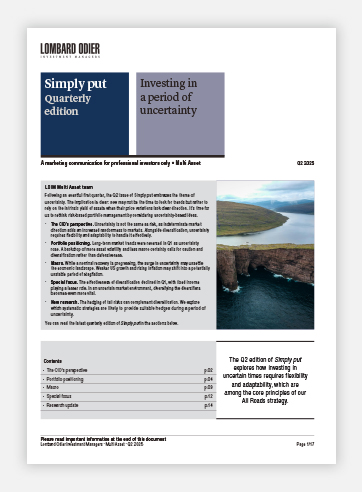 |
Simply put quarterly edition: Investing in a period of uncertainty. |

Following an eventful first quarter, the Q2 issue of Simply put embraces the theme of uncertainty. The investment implication is clear: now may not be the time to look for trends but rather to rely on the intrinsic yield of assets when their price variations lack clear direction. It’s time for investors to rethink risk-based portfolio management by considering uncertainty-based ideas.
Uncertainty may be a constant in our daily investment life, but high levels of price fluctuation risk are seldom seen. It's crucial to recognise that uncertainty is not the same as risk and requires extended investment techniques to be handled effectively.
Essentially, risk involves situations where the probable outcomes are known, and occurrence probabilities can be assigned to them. Uncertainty, on the other hand, involves scenarios where outcomes are unknown, making it impossible to assign odds. Risk can be more easily hedged as it presents a somewhat predictable market direction, whereas uncertainty involves an indeterminate market direction, adding an increased randomness to the markets.
Currently, the roll-out of economic policies by the Trump administration represents a scenario with uncertain outcomes. We may have a reasonably clear understanding of the President’s political agenda and priorities, but their broader impact and other parties' reaction functions are unknown. The US economy could either strengthen or weaken as a result, and the implications for company earnings, the creditworthiness of global companies and rate fluctuations are extremely challenging to calculate. This is the essence of uncertainty.
Read also: Will US market concentration fade in 2025?
Considering the historical performance of markets and strategies in the context of uncertainty, we find that Sharpe ratios tend to decrease for most asset classes and strategies, including bonds. Rising uncertainty does not favour bonds as an asset class, which typically offers higher than usual returns when risk rises. Asset classes and strategies that rely on clear market trends also suffer during periods of high uncertainty. In contrast, carry strategies appear to be the only ones where the Sharpe ratio improves.
FIG 1. Sharpe ratio per asset class, portfolio allocation and systematic strategies1

Our analysis seems to deliver a clear message: uncertainty differs from risk and should prompt portfolios to lower market exposure and focus on carry strategies.
2025 has begun like a roller coaster, with many market developments already unfolding. These include a reversal of the prolonged US/growth/tech trade and a value recovery spearheaded by Europe and emerging markets. Examining the indicators that make up our investment dashboard has been informative – from assessing risk and trends, to interpreting fluctuations in market sentiment and macroeconomic data – and helps us understand how these factors impact our market exposures.
Our trend monitoring system reveals intriguing signals, highlighting notable trend rotations within each asset class. Specifically, the trend for US equities has weakened, whereas it has strengthened for equities in emerging markets and other regions. Conversely, trends for US bonds have strengthened, while those for European bonds have softened.
As systematic portfolio managers, this regime of trendless market evolution presents an interesting test for our investment process, questioning the level of diversification our investment solutions can provide. We consider whether the rise in uncertainty will challenge diversification by examining the historical behaviour of our solutions’ diversity ratio and the changes since the new US administration took office.
The concept of diversification is a fundamental aspect of investment, combining assets results in portfolios that exhibit lower volatility than their components. This can typically be measured through the ‘diversification ratio’, which compares the sum of the risk contributions from the portfolio's individual constituents with its overall volatility. The higher the ratio, the more significant the diversification provided by the portfolio.
Figure 4 presents the evolution of this ratio since 2015 for our All Roads strategy and a 50/50 portfolio. Firstly, it underlines the scale of our opportunity set (the assets and strategies we use as constituents) as well as our dynamic portfolio management methods. Secondly, it highlights that diversifying your diversification sources is also vital, as it helps maintain portfolio diversification even during challenging times.
FIG 4. Diversification ratio through time for All Roads and a 50/50 allocation4

In times of uncertainty, it's also insightful to analyse the individual sources of diversification to determine if these contributors are changing and identify which asset class currently provides the best source of diversification. Since the beginning of the year, there has been a decline in diversification, with bonds being a less effective tool than they have been in the past. Risk-based investing, nonetheless, continues to show better diversification than its market cap counterparts.
In these turbulent times, we continuously monitor such metrics, recognising that diversification – which essentially means not relying solely on the stability of uptrends – is an answer to uncertainty.
The hedging of high-risk regimes has always been paramount to portfolio construction. Although diversification – particularly for multi-asset portfolio managers – helps mitigate specific risks, directional portfolios remain exposed to sharp drawdowns in high-risk environments when assets re-correlate across asset classes.
In these extreme scenarios, solutions are well known: macro-timing, trend following and long volatility exposure may act as tail hedges. Regimes of high economic uncertainty – when returns are less informative about future trends – have attracted far less attention. We use history as a guide to finding the right systematic strategy for 2025.
Risk must be distinguished from uncertainty. In adverse regimes, the situation is often crystal-clear: prices are falling, volatility is rising and macroeconomic conditions are deteriorating. High-risk regimes, therefore, come with a set of relatively strong signposts that are usually hard to ignore. Uncertainty periods are more elusive and require a more formal definition. In addition, they do not tend to coincide with higher risk periods.
By examining policy-related economic uncertainty (Figure 5), we find the trend following strategy is particularly impacted by high economic uncertainty, as price action becomes less predictable. Whereas carry strategies, which aim to harness returns that are not extracted from the expected price variations, show the highest Sharpe ratio increase in periods of acute policy-related economic uncertainty and prove a good hedge to trend in such environments.
Additionally, the cross-asset value strategy presents an appealing U-shape, outperforming in both low- and high-uncertainty regimes, as expensive assets may suffer from profit-taking during periods of uncertainty. Finally, the macro strategy unsurprisingly suffers when macro uncertainty is high as macro regimes are more difficult to infer, while it performs well in low uncertainty environments.
FIG 5. Excess Sharpe ratio of cross-asset strategies in different policy-related economic uncertainty regimes5

Uncertainty calls for an extended set of systematic strategies to increase diversification. In this instance, carry and value could prove helpful.
important information.
For professional investors use only
This document is a Corporate Communication for Professional Investors only and is not a marketing communication related to a fund, an investment product or investment services in your country. This document is not intended to provide investment, tax, accounting, professional or legal advice.
Read more.